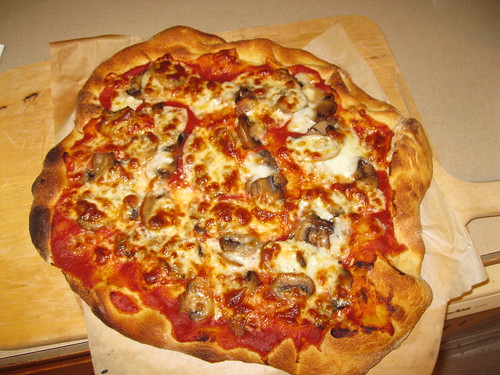 |
| Cornmeal Crust Pizza |
The pizza joint was in a building about the size of a postage stamp with an even smaller parking lot. By the time we moved this past winter, it had risen to a grand, two-story affair with a bar, a more extensive menu and an upstairs section where musicians sometimes played.
At some point during those years, the owner recognized us by the order. “Is this for M—?,” he’d ask after I made my request. “OK, 25 minutes.”
The Friday night pizza was a relief for two working souls bone tired from the week. Looking back, the pizza and the relationship we developed were constants amid the many variables of our time there.
Because our neighborhood pizza was so good, I only dabbled with making pizza from scratch, never baking with any sort of regularity, just when the mood struck. The results were always satisfactory, and sometimes even good, but they were not stellar.
This week I made a stellar pizza.
 |
In a class with Chad Clark at New Pioneer Food Co-op, I sampled different styles of crusts and learned techniques for making a good pizza. My favorite was the one with cornmeal. I liked its chewiness and the lovely air bubbles that formed around the edges.
That’s the crust I wanted to try first using my newfound pizza wisdom. In keeping with tradition, I made it with mushrooms and cheese, though I forgot to add the garlic.
Here are some suggestions:
1. Prevent a soggy crust
One problem that has plagued my pizza efforts is that the crust would sometimes be soggy in the middle. Chad recommends baking the crust for a few minutes before dressing with sauce and toppings, which will give the crust time to firm up. This worked for me.
2. Enable a smooth transfer to pizza stone
If you are challenged by sliding a crust onto a pizza stone, add a small handful of cornmeal to the pizza stone and the wooden paddle. Pre-baking the crust for just a few minutes will prevent the raw dough and its toppings from sloshing around as you place it on the stone.
I like using parchment paper because it is my fail safe measure. Parchment will allow the crust to brown while preventing almost anything from sticking.
3. Create good flavor and structure
I mixed my dough the day before, then refrigerated it. This slow, cold rising facilitates both structure and flavor. The next day, the dough was beautifully supple and easy to roll.
4. Cook your mushrooms ahead of time
Mushrooms release a lot of liquid as they cook, which can lead to a soggy pizza. Sauté them before adding to the pizza. This also brings out their flavor.
Here is a link to recipe for cornmeal crust pizza at Chad’s website blinddogpizza.com. I’ll be baking the other pizza crusts and will share my results in future posts.
No comments:
Post a Comment
Thank you for visiting my site. Please leave a message!
-Lisa